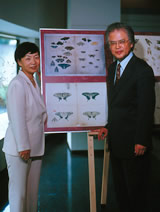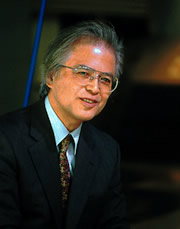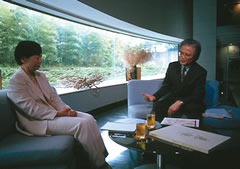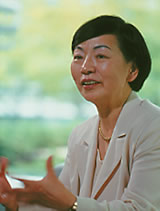| Biohistory journal,Winter, 2003: Index >The Perspective that Transcribes Life |
| Dialogue/Philos The Look of Philos The Perspective that Transcribes Life Johei Sasaki and Keiko Nakamura |
|
|
|
| Dr. Sasaki says it is important that researchers have the compass of scholarship. I sensed common ground between the approach of the Biohistory and Dr. Sasaki. Behind the sketching, which he thought was natural to learn in primary school, was the philosophy and talent of Maruyama Okyo, who developed a discerning eye from a love of creatures and the lenses that were the advanced technology of the time. He is an important person when it comes to thinking about the future of the Biohistory Journal. (Keiko Nakamura) |
 |
 |
Ending the dialogue / Johei Sasaki |
| Today, there is a flood of such expressions as IT or the genome, and such important words as life and information sparkle and shine, not only in the field of technology, but also our everyday activities. Our dialogue seemed to have a sense of continually questioning this, trying to call a halt to the trends in contemporary society, and saying that something was wrong. Even when life becomes an issue in contemporary society, what becomes of the life of the existence that is alive? The view toward a sensibility that cares for even the smallest life created the idea of thinking in terms of the important word, philos. I am relieved that there are, without question, scientists who have this sensibility. I was very moved by the sensibility of Dr. Nakamura, who suggested the potential that a new light could be shed on a true science of human revival from the world of beauty from the trinity of goodness, truth, and beauty. |
| Of Maruyama's sketches: The first shows truth. The second shows falsehood. The third shows spirit. The fourth is a space in which truth and falsehood are integrated. |
 |
 |
Why is this here? Science is explaining things that can be seen using things that cannot be seen. One could say that was what Maruyama depicted. |
| The editorial staff |
| This is the third Philos dialogue--first philosophy, then developmental biology, and now art. This Dialogue was recorded at the Biohistory Research Hall exhibition hall with its collection of symbolic works. It was the first time Dr. Sasaki had come to the Hall, and he stared up at the three-dimensional phylogenetic tree. The Biohistory Research Hall creates its art and videos only on the basis of concrete, objective data. How did it look to the eye of Dr. Sasaki, who comes in contact every day with venerated art and deeply understands the artistic spirit? The subject of Prof. Sasaki's research is the Edo Period artist, Maruyama Okyo (1733 - 1795). He transformed the art of his time as a pioneer of realistic sketches. His sketchbook was filled with drawings of plants and animals so true-to-life that one could identify their species name. His illustrations of people are influenced by Chinese divination. He made observations with lenses and telescopes that were the most advanced instruments of his time. In an age when artists tried to depict the spirit of their subjects on paper, Okyo established the practice of observing what was actually there and objectively portraying that. Ultimately, he tried to convey the beauty of nature. This is indeed philos itself. Making philos the centerpiece of both Maruyama and science resulted in a dialogue in which the mention of ideas about their links and the individual ideas of both participants brought the immediate citation of specific examples. What are pictures, after all? During the course of tracing their essence, the question 'What is living?' then arose. That is indeed equivalent to a biological question. We felt that the mother ‘the princess who loved the insects’ and the father ‘Okyo’ a would give birth in the future to a wisdom about living things. |
| Johei Sasaki Born in Hyogo Prefecture in 1941 Graduated from the Kyoto University School of Letters Prof. Sasaki is currently a professor in the Department of Aesthetics and Art History, Graduate School of Letters at Kyoto University, and the Director of the University Library. His specialties are art and art history, specifically the pre-modern period in Japan. |
| Dialogue |
|
Please close a window with the button of a browser who are turning off Javascript. |